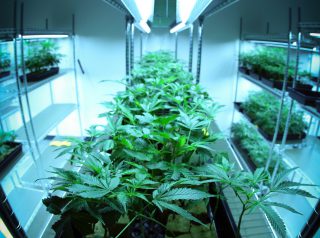A key component to a successful grow is light. This is normally provided by the sun but, in its absence, growers can turn to grow lights. Unlike the standard household light, these specially designed fixtures are designed to provide indoor plants with the light it requires to flourish.
There are different types of grow lights for sale. They differ in price point, energy efficiency, efficacy, and costs, and even their use with regard the scale of operations. Check out this quick and easy guide on the different types of grow lights commonly used for growing marijuana.
Page Content
Fluorescent Lights
Fluorescent grow lights, not to be confused with fluorescent household grow lights, are lights calibrated for growing. They are usually used during the early stages of a plant’s life, aiding its development as it matures. It could also support a small garden cultivated by first-time growers or hobby gardeners with one or two plants.
Compact Fluorescent Light (CFLs) bulbs are the most popular choice of fluorescent lights. They are easily available, often found in hardware stores and home depots. They provide enough light for narrow areas, grow tents, small gardens, and beginner grows but may not cover a wide surface area.

For slightly larger gardens, people use fluorescent tubes over the bulbs. These tubes, which are calibrated by diameter, are often denoted by the letter ‘T’ which represents 1/8th of an inch. T5 Grow Lights would mean 5/8th of an inch. They can be found in many home or garden centers.
Due to the low power, fluorescent grow lights barely burn the tops or leaves even when placed nearer the plant. Along with its purple-white spectrum, the low heat is ideal for cloning, seedling, and young plants. Hobbyists can take the plants full term on just fluorescent lights, but professional growers often turn to more powerful alternatives once the plant enters the vegetative and flowering phases.
HID (High Intensity Discharge) Lights
High Intensity Discharge (HID) Grow Lights are an expert grower’s choice when it comes to indoor lighting. Its powerful, bright light provides the highest yields per watt of electricity out of all the grow lights especially when boosted by a reflector. These long-lasting bulb systems usually have two types.

- Metal Halide (MH). MH lights produce an abundance of blue spectrum light which simulate the light produced by the sun during the spring time. It is ideal for the vegetative phase wherein the plant develops a thicker stem, a bushier foliage, and stronger structure overall.
- High Pressure Sodium (HPS). If MH lights exude a blue light, HPS systems emit yellow-orange-red glow which triggers hormones signal the plant to start budding or flowering. This mimics the light the sun produces during autumn or fall.
Both are easy to set up and have been proven to give growers the best results. A combination of MH and HPS is usually what is used to attain the desired trichome and bud production. If any, the only problem that HID light systems have is that they tend to produce a lot of heat. As a result, plants tend to show heat stress such as burning at the tips or dry, yellowing leaves. Grow areas would need efficient exhaust fans and vents that would keep the place cool.
LED (Light Emitting Diode) Lights
Light Emitting Diodes (LEDs) have become popular over the years. In fact, today, it is considered as the grow light of choice for many hobbyists and professional growers. They are much more efficient compared to fluorescent lights, produce less heat than HIDs, and last fairly longer than either.
These energy efficient light fixtures are easy to use too. They come in different shapes and sizes that cater to different growing needs. It also has a higher light production which could be adjusted depending on the make and model of the light.

Many LED lights are already in the wide or full spectrum. It contains both blue and red light and, as such, can support the plant during both the vegetative and flowering phases. There is even a tinge of green light, which encourages healthier growth. And because it does not get as hot, it does not expose the cannabis plants to heat stress.
Perhaps the biggest problem that growers will face is the initial cost. LED lights and systems are more expensive than HID and fluorescent lights to set up especially for bigger business operations. If it is any consolation, however, using LED systems does reduce costs in the long run. For instance, there would be no need to buy separate vegetative and flowering lights. Hobbyists can also save up on replacements since these lights do not need changing often.
Research Thoroughly
Light provides indoor cannabis with the necessary energy it requires for photosynthesis, effectively helping it grow bigger and produce impressive yields. Deprived of light, plants could experience slowed or stopped growth.
Grow lights play an essential role in the absence of natural sunlight. And it can be quite daunting, especially with so many choices available. However, installing any of the aforementioned light fixtures without tailoring it to your needs could end up in a disaster. So, remember to do further research on the make and model you have set your eyes on.





